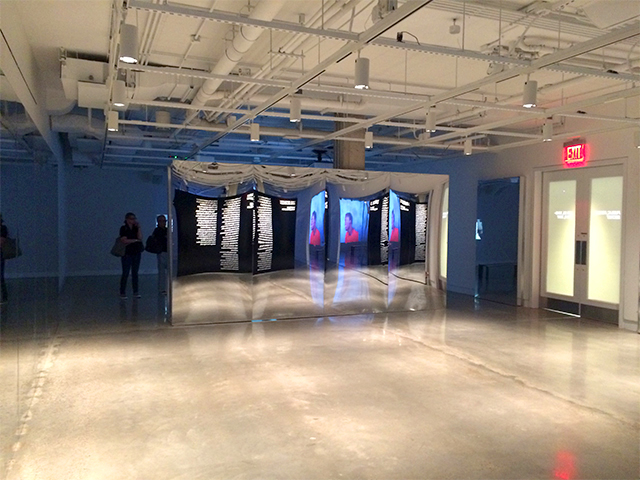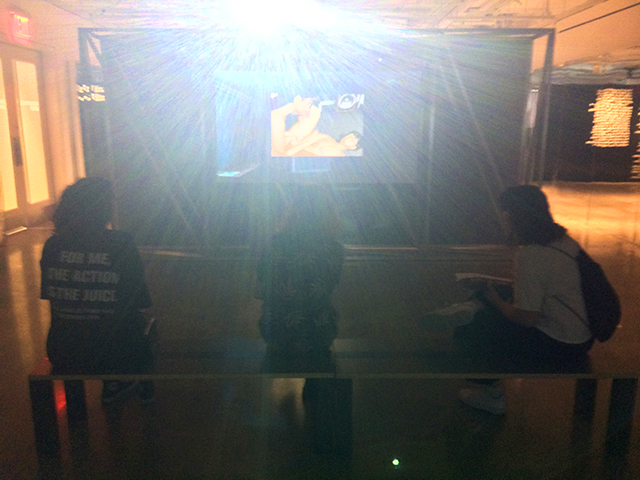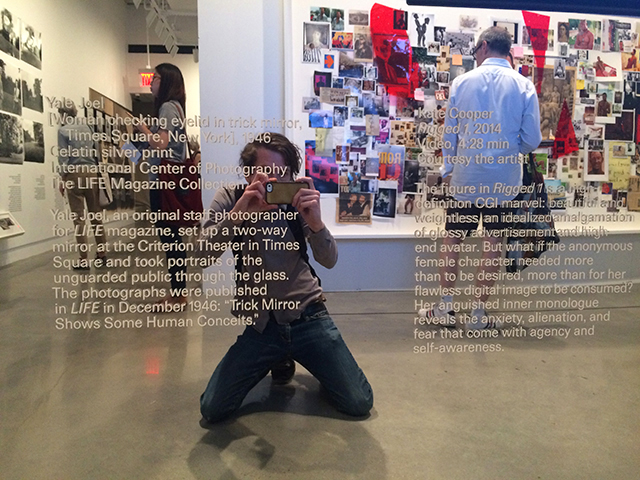
Exhibition as funhouse.
For a prime example of ambitious curating standing in the way of excellent artwork, look no further than the convoluted mess of a show at the International Center for Photography’s brand new Bowery location. While I’m always up for seeing art that takes advantage of technology and addresses our weird wired world, this show is filled with wrong-headed assertions, painful hanging choices, and eyeball-straining design.
That’s not a conclusion I’d hoped to come to. This is the museum’s first show since moving downtown from their old digs. They need to get people in the door, so I really wanted to find something positive to say. I did, but it definitely took some effort.
The exhibition, “Public, Private, Secret,” (on through January 8, 2017) hopes to explore photography’s relationship with trendy topics like surveillance, social obligation, self-identity, social identity, the ways that social identity becomes self-identity, media overload, attraction, sexuality and much more. It’s a big, far-reaching premise that could and should have germinated eight sharply focused shows, not one giant sprawling mess.
The problems start pretty much the moment you walk in the door. It’s a two-floor space and 80 percent of the top floor is dedicated to a coffee shop and lobby. The layout alone should be insulting to any artist who shows there and gets short shrift to a bunch of pastries. And that’s to say nothing of the museum’s permanent collection, which is housed in a storage facility in New Jersey.
Walk through the shop to the exhibition area and more problems arise. Mirrors cover nearly every surface of this show as if viewers were touring a nausea-inducing fun house. All art and text are displayed on top of these mirrors, a distracting experience to say the least. There are breaks in this setup, but like a true house of horrors, there’s never a time when the viewer can wholly escape the mirror.
Begin with the first room a viewer enters, which is divided into three parts. In the center section, the viewer is surrounded by mirrors, one of which is covered in descriptive exhibition text. Get used to this. Much of the show is staged on mirrors.
As context for an exhibition that wants to, at least in part, focus on “the pressure to participate in and labor for the culture of public visibility,” this attempt at creative curation is pretty reductive. Here we are, looking at ourselves just like we do on the screen of our smartphone. A deliberately placed wall label informs us that we’re being recorded on CCTV. Okay.
The other two sections of the room feature two projections each, that face each other. Each projection is by a different artist and there are four videos in total. In one section, both videos heavily rely on sound and they are so close together that it’s impossible to hear one without the other. The four videos on this floor focus on found footage.

Standing in front of Natalie Bookchin’s “Testament,” means you have to block the projection.
The section with the problematic sound features Jon Rafman’s piece, “Mainsqueeze,” which is a collage of found videos like a woman crushing a live crawfish with her foot and Anime porn. Throughout the piece a malfunctioning washing machine gradually destroys itself. The text describes “Mainsqueeze” as a distillation of “what people are compelled to make, share, and search for online, honing in on the slippery border between the seductive and the repulsive, inspired and demented, speaking to a contemporary social and moral condition without passing judgment.” Not exactly. From the title, “Mainsqueeze,” it’s obvious that the primary focus of the video is on sexuality, desire or companionship. The squeeze pun comes along with a crawfish “crushing fetish” video. Anime and Furry Bondage fetishes are also highlighted. And that washing machine that continues to pop-up is just an example of “destruction porn.” It’s tough to say for sure that Rafman is passing judgment, I don’t think he’s fetish-shaming here but the music sounds ominous and the found video choices are presented in a sort of disturbing and jarring manner. When you throw in the chaotic unraveling of the washing machine it has that “life out of balance” feeling that Godfrey Reggio defined with his “Qatsi trilogy.” Maybe if the curators were better able to hear the sound they wouldn’t have felt so strongly that Rafman has taken a neutral viewpoint.
Arguably more offensive, though, is the work that’s been altered to suit the architecture of the space. To go downstairs to the next section of the show, you pass an adhesive print by Kurt Caviezel that collects stills from a video stream of a man rehearsing choreography along with a projected video of a dancer. The print is placed in a really shitty location and it’s been cut to make room for a fire extinguisher and a thermostat. This irreverent approach doesn’t turn lemons into lemonade, it just makes a bad location extra bad. The Caviezel piece gains nothing from the way it’s hung. Rather than contemplating the art, I spent my time contemplating the fact that I could put out a fire if need be and that it’s a comfortable 70 degrees in the room.

It’s 70 degrees.
Once you hit the lower floor, there’s a ton of work, most of it backed by the aforementioned mirrors and wall text, wall text, wall text. Sometimes, a block of wall text takes up more space than the work it’s describing. The explanations and credits compete with artwork for your attention and invariably the text wins.
The pieces are arranged into broad left-to-right themes like “Fame,” “Surveillance,” “Media Shame,” “Racial Identity” etc. There’s no way to separate one concept from another because it’s all tightly spaced and everything is reflecting everything in those fucking mirrors.
The show is impossible to document without including yourself in the photo. By the time I made it to the second floor I just gave up on photos. My last attempt is captured below.

Don’t do this.
The problems are seemingly endless. I haven’t even gotten to the Larry Clark-led evolution of sleaze section or the ubiquitous Twitter streams that tell me exactly zilch about our culture but life is short.
Despite all of the flaws in the presentation and the lack of rigor in the exhibition’s thematics, there is some good artwork to be seen and some successful groupings of pieces. For example, a good historical inclusion in the show is a presentation of photo cards that Sojourner Truth produced after her emancipation. The cards were originally sold by Truth to raise funds for abolitionism and women’s rights. Nearby, a selection from Barbara DeGenevieve’s “Panhandler Project” hangs. It depicts a naked African-American man lounging on a hotel room bed. The artist paid panhandlers $100 and a stay in the hotel room for the night in exchange for posing. The juxtaposition of the famous abolitionist using a photo as a means of support and this modern black man doing the same is an excellent illustration one of the shows stated intention to explore photography and identity.
Elsewhere, there’s an excellent section dedicated to work revolving around Michelangelo Antonioni’s film “Blow-Up.” Three pieces from different artists and eras raise questions about the reliability of photography as a documentary medium and our often misguided faith in technology and perception. A through line begins with photos taken by Don McCullin for the film. These stills were presented in Antonioni’s fictional narrative as having been taken by the protagonist, Thomas, a fashion photographer who may or may not have documented a murder. The character becomes an amateur detective and spends the rest of the film obsessing over the photos and looking at them from every possible angle. In the end, he’s frustrated with no more answers than he began with. Next, we see images of the area surrounding the site of the 2013 Boston Marathon bombing. You may remember that the internet seized on these images and, through a little #vigilante sleuthing, implicated the wrong people as perpetrators of the bombing. The third piece is a video by John Houk that uses custom facial-recognition software to search images from “Blow-Up” for faces. The constant misidentification of patterns in wallpaper and clothing as faces is pretty hilarious. So you have three pieces that fit together through theme and subject matter while also being just the right kind of ambiguous. If only the rest of the show were as succinct.
My favorite section of “Public, Private, Secret,” takes the simplicity of the “Blow-Up” section even further. A courtroom drawing of Chelsea Manning’s 2013 trial for leaking government secrets hangs alongside Trevor Paglen’s “Blue #3.” The large chromogenic print by Paglen was made by photographing one of the Manning courtroom drawings hundreds of times with a microscopic photo system and stitching them all together into a big, beautiful abstract that consists of color washes and millions of little fibers from the illustrator’s paper. You could interpret this as a nod to the many threads going on behind the scenes of the trial that are virtually unknowable or society’s inability to see the forest for the trees in this particular case. Or just look at it. Never underestimate an artist using real world material just to make something.
The barrage of images-in-images and text all over functions as a barrier to feeling at this show. But the Paglen made me feel pleasure. And in the context of an exhibition that made me feel like I had a migraine coming on, it was a welcome and needed respite.


Comments on this entry are closed.